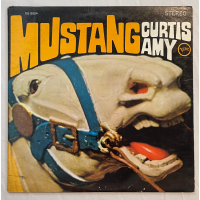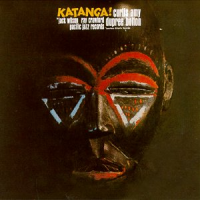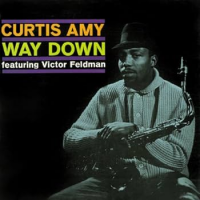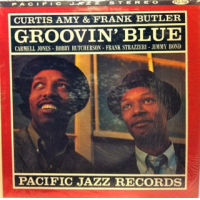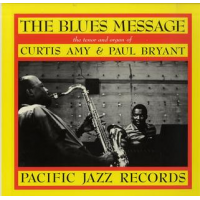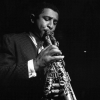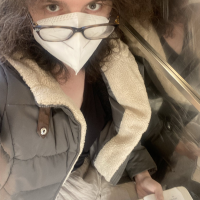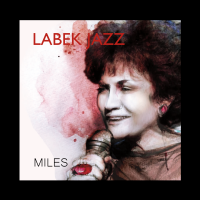Home » Jazz Musicians » Curtis Amy
Curtis Amy
Coming out of the Texas Tenor tradition of honkers, Curtis Amy was of the same generation as Booker Ervin, David Fathead Newman, James Clay, and Wilton Felder, but his time in the jazz spotlight was brief. Amy had a beautiful sound and a style that was both brawny and lyrical. The major influences on Amy's style were the tenor saxophonists Gene Ammons and Sonny Stitt. Although he had a long and successful career in his transplanted home of Los Angeles, much of it was spent doing high-profile studio work and working with his wife, the extraordinary vocalist Merry Clayton.
Born in 1927, Amy had taken up the clarinet when he was a child, and in 1946 enrolled at Wiley College, in Texas, to continue his studies. He dropped out and then worked as a postman before joining the US Army in 1947. He took up the tenor saxophone while in the Army. Afterwards, Amy resumed his studies and at 19 he was awarded a scholarship to Kentucky State College. He achieved his bachelor's degree and then taught music in a high school in Tennessee. In 1955, he moved to Los Angeles, where he put together a quintet with the trombonist Melba Liston. He went on to join the rhythm and blues group led by the pianist Amos Milburn and led a variety of groups of his own, using such outstanding local jazz musicians as Carmell Jones, Roy Ayers, Victor Feldman, and Kenny Barron.
In 1960, Dick Bock, the head of Pacific Records, gave Amy a contract and, by 1962, his band was making television appearances. He also began to teach music privately, an occupation that was to sustain him over the lean years ahead. During his years with Pacific Jazz (1960-63), he recorded six superb albums that revealed an artist who constantly challenged himself as an improviser and as a composer. After “The Blues Message” and “Meetin’ Here,” two soulful collaborations with organist Paul Bryant, he moved into more textured hard bop surroundings, fronting sextets with varied instrumentation. He and Frank Butler co-led “Groovin’ Blue,” which features Carmell Jones and Bobby Hutcherson. “Way Down” includes Roy Ayers, Marcus Belgrave, Victor Feldman, and valve trombonist Roy Brewster among others. “Tippin’ On Through” was recorded live at the Lighthouse with Ayers and Brewster among others.
But his "soul" jazz was fashionable throughout the Sixties. He recorded and appeared with Les McCann and toured and recorded with Ray Charles for three years. He made his first album with the Doors, “The Soft Parade,” in 1969 and recorded with the band until 1983. He appeared on Carole King's huge 1971 album “Tapestry,” and backed his wife, the singer Merry Clayton, on her 1994 album “Miracles.” Clayton also sang on Amy's last album under his own name, “Peace For Love,” in 1994.
Read moreTags
Curtis Amy: Mosaic Select 7

by Colin Fleming
Relatively unknown as far as storming tenor players go, Texas-born Curtis Amy perhaps wasn't so storming after all, as this set suggests.
Familiar to rock fans for his solo on the Doors' “Touch Me, Amy was more restrained, more a player of shadings and touch, than his reputation and birthright might lead one to believe. These sessions for the Pacific Jazz label, all cut in the early '60s, open with two albums of the then exceedingly popular combo of organ ...
Continue ReadingMosaic Select 7: Curtis Amy

by C. Andrew Hovan
Curtis Amy Mosaic Select 7 Mosaic Records
I can still remember doing an interview with Mosaic's Michael Cuscuna several years back when I felt compelled to probe him about the lack of reissues from African American artists who happened to record for the Pacific Jazz label. Many still associate Richard Bock's imprimatur with the 'cool school' and such artists as Gerry Mulligan and Chet Baker and fail to understand the full scope of the label's deep ...
Continue ReadingCurtis Amy: Mosaic Select 7: Curtis Amy

by AAJ Staff
Although saxophonist Curtis Amy gained wide exposure taking solos on pop tunes like the Doors' “Touch Me" and Carole King's “It's Too Late," he was in fact a superior jazz musician, a soulful, warm hard bop Texas tenor, and a probing soprano soloist. He was also a provocative, wholly original composer. Between 1960 and 1963, Amy recorded six albums for Pacific Jazz, including the brilliant Katanga!, all of which are reissued here on the seventh installment in the Mosaic Select ...
Continue Reading
